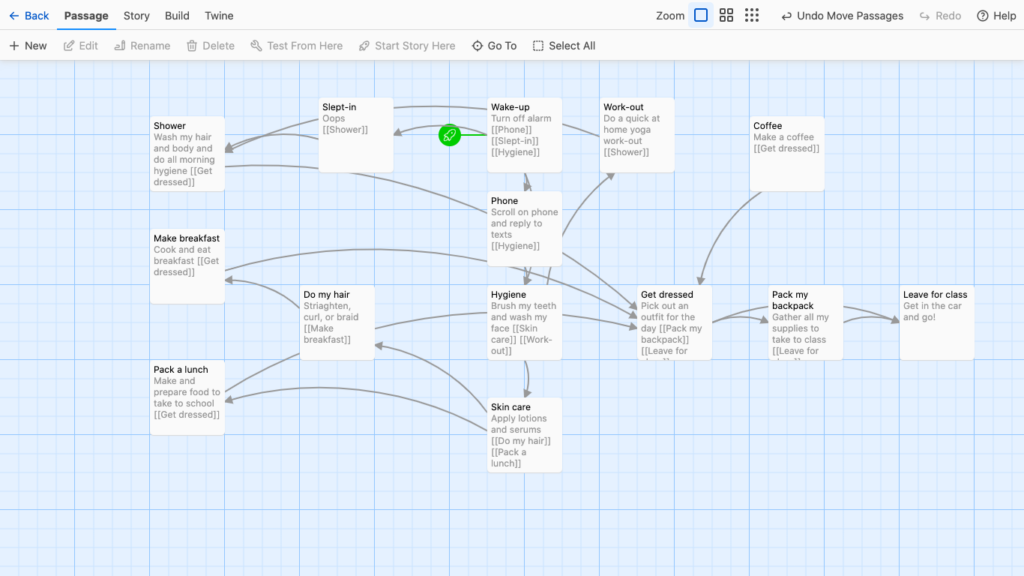In this module, we examined various storytellers and their techniques to portray a meaningful story effectively. Additionally, we explored the Twine platform and how it can be used to create our branched narratives. Please see my blog post below to see how things went!
The TED Talk presenters from, “7 Storytelling Techniques Used by the Most Inspiring” I found most compelling.
I was extremely impressed by all the presenters in the “7 Storytelling Techniques Used by the Most Inspiring” video we got a chance to watch this week. Each individual was extremely composed and portrayed their stories in a captivating manner. The speaker whom I found most compelling was Malcolm Gladwell and his talk on “Choice, happiness and spaghetti sauce”. The reason I thought this was because of how he brought to life the story of his friend Howard. Despite Howard not being in the room nor a picture of him show- based on how Malcolm described this character I truly felt as though I knew and could picture Howard and all his quirks. Additionally, Malcolm spoke so highly of his friend and with such great admiration. This made me care about his story and the impact he made in his career. So much so that I researched Howard more on my own time! This was because I grew to like him as a person from how Malcolm brought to life his personality. Additionally, I enjoyed Maclom’s comedic tone he had throughout the entire presentation. For example, including little sayings and jokes Howard himself would use made learning about an inherently boring topic of spaghetti sauce an exciting experience!
The storytelling technique I recognized during the Ted Talk
A technique that I felt Malcolm did a great job with was “immersing the audience in the story”. Despite not showing many images or videos during his presentation I think Malcolm did a great job of doing this verbally. Throughout the presentation, he introduced elements in thorough detail and description. This helped activate my senses, especially when he spoke out about the food. I felt as though I could taste the sweetness in the Pepsi he was describing or, even see the chunkiness in the pasta sauce he touched on. The use of this technique as a listener helped me to feel engaged and not lose interest throughout the entire duration of his 18-minute-long presentation. This intense high level of description is something I will try to use in the future. I find that sometimes my writing can be a bit boring and dry. So applying for description, and thoroughly explaining things it will help keep the reading tuned in. Moreover, he touched on generic items most people have encountered before, such as mustard and coffee. My first-hand experience with the products as a consumer aided me in plunging into the story world he had established.
Branched narratives through Twine
Please see the attachment below for the branched narrative I created using Twine! The topic I chose to showcase was a morning get-ready with me for school. I decided to explore this topic because I love watching these kinds of videos on YouTube and TikTok as I find them calming and interesting.
This was my first time creating my own branched narrative and using Twine. That being said, Twine allowed me as a learner to design my story in a user-friendly interactive manner. Brached narratives like Twine allow learners to view all elements of the story collectively as a whole and a whole as well as, an individual entity. By being able to view all the parts of a story together on one grid I could see what parts were missing and how each piece led to another. Next, branched narratives utilize arrows to connect ideas. This helped me link my thoughts, and it provided a guide to see how each step flows from one to the next. Also, the arrows allowed me to think less linearly about my story-building process. Having the ability to branch off at any point enouged me to explore different routes my story can take at each step of the way. Another point I liked about Twine allows you to make notes in each element. Even so much as including one-word headers, helped me to organise my ideas and explain my thought process throughout the entire experience. I found this helpful, as I could leave and come back at any point during my creating process and know exactly what I was thinking previously.

Other uses of branched narratives
I have seen the use of branched natives as early as a child, in story books where you can jump from chapter to chapter to customize your reading experience and storybook ending. More recently as an adult, I have seen branched narratives in t.v. show, such as “Black Mirror”. Producers made a series of episodes in which each viewer got a different sequence to watch the show. Thus, depending on which order one received each person had a different ending. I think branched narratives are a great use of media! They add excitement to the traditional schema of storytelling, by giving “power” to the audience to choose their outcome. Rather than experiencing the direct narrative path the author had concretely laid out for you. Also, I think that branched narratives are very socially engaging. I remember how much excitement and discourse both the stories in elementary school and t.v. series as a young adult created when first came out. People were eager to share their unique experiences and hear about what others thought of processes and endings. Please leave a comment, as I am curious to hear about your experience with branched narratives!
Leave a Reply
You must be logged in to post a comment.